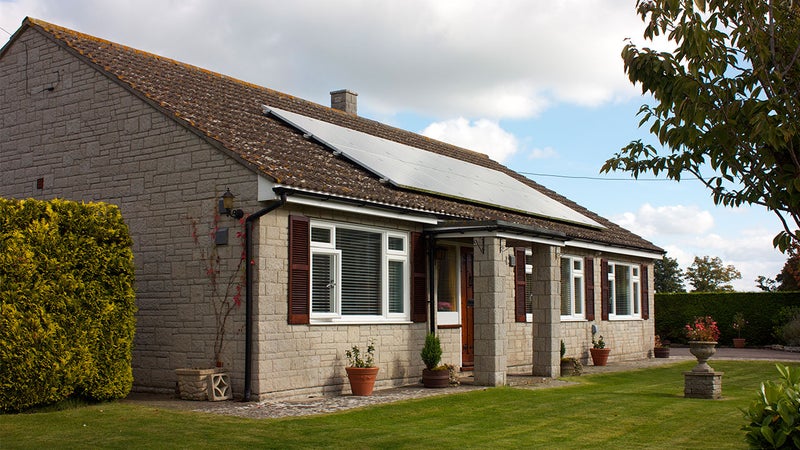How to calculate your home equity — and how much of it you can tap

The Bankrate promise
At Bankrate we strive to help you make smarter financial decisions. While we adhere to strict , this post may contain references to products from our partners. Here's an explanation for .
Home equity can be a valuable resource for homeowners. You can use your equity to renovate some rooms, pay off credit cards, cover college tuition, start your own business … or almost anything else.
Before you can explore how to use this source of wealth, though, you need to know how much you have. This figure, along with your loan-to-value (LTV) ratio, determines the likelihood of being approved for a home equity loan or home equity line of credit (HELOC), and how much money you could be eligible for. Here’s how to calculate the equity in your home.
How to calculate the equity you have in your home
Key terms
- Home equity
- Your equity is basically the difference between your home’s value and the amount you owe on your mortgage (and any other loans against the home).
- Loan-to-value ratio (LTV)
- Your LTV or loan-to-value ratio is the size of your mortgage vis-à-vis your home’s worth. Expressed as a percentage, it’s computed by dividing the principal balance of your mortgage by your home’s appraised value and multiplying the result by 100. Lenders consider it when approving you for a mortgage or other home-based financing.
- Combined loan-to-value ratio (CLTV)
- Lenders calculate your CLTV or combined loan-to-value ratio when you apply for a second mortgage. It represents the total debt against the home: both the original mortgage and the size of the new home equity loan or line of credit.
Calculating home equity is relatively simple math, and if you have accurate figures on hand, all you have to do is plug them into a home equity calculator. You can determine your level of equity on your own, as well. Here’s how.
Step 1: Estimate your home’s value
Calculating equity starts with identifying the property’s market value. You can find out how much your home is worth using a number of methods. Online home price estimators are an easy (and free) way to gauge your home’s worth. These popular online tools rely on algorithms and publicly available information to generate estimates — just keep in mind that the results really are estimates, not necessarily the true amount you could sell for.
When you input your address in an online estimator, the dollar amount you’ll get is an estimate of the property’s fair market value, which might not be the same as the home’s appraised value. Home equity lenders rely on a home’s appraised value — based on a professional appraiser’s assessment — to determine your equity level and how much you can borrow. The fair market value of your home simply refers to what a homebuyer would likely pay for the property today.
Step 2: Find out what you owe
The next number you’ll need is the outstanding balance on your mortgage, which can be found on your most recent statement. You could also check your lender or servicer’s online dashboard, assuming it has one, or call directly for this information.
Step 3: Take the difference to determine your equity
Once you have your home’s value and your mortgage balance, calculating equity just requires basic subtraction. Your home equity equals the current value of your home minus your current mortgage debt.
Assume your home’s current value is $410,000, and you have a $220,000 balance remaining on your mortgage. Subtract the $220,000 outstanding balance from the $410,000 value. Your calculation would look like this:
In this case, your home equity would be $190,000 — a 46 percent stake.
Step 4: Calculate how much you can borrow
You can’t borrow the full amount of your home equity. Many lenders allow you to borrow only up to 80 percent.
Using our example above, that’s 0.8 x $410,000, or $328,000. Subtract $220,000 (what you still owe on your mortgage), and you’d have $108,000 of tappable equity.
So, to get a rough sense of the amount you could potentially borrow using our example above, your entire calculation would look like this:
Keep in mind: It’s not free to take out a home equity loan. These loans come with some closing costs, similar to taking out a traditional mortgage, which can include fees for loan origination, an appraisal and credit report and title searches.
Calculating LTV and CLTV ratio
Once you know how much equity you have in your home, you can explore borrowing against it. However, when you approach a lender about this option, they won’t be looking solely at your equity amount.
Specifically, the lender will look at your LTV ratio, or your loan balance divided by your home’s value, expressed as a percentage. To do this math, use Bankrate’s LTV calculator or, using the above example, make the following calculation:
When you add a home equity loan to your debt load, lenders look at the combined LTV (CLTV) ratio. The CLTV includes your first mortgage and any other loans attached to your home — including the HELOC or home equity loan you’re applying for.
For example, if you wanted a $30,000 home equity loan, your CLTV would come to 60.97 percent:
The higher the LTV ratio, the more risk for the lender. And the higher an interest rate they’re likely to charge you.
How to access your home equity
Once you know how to calculate home equity and how much you can borrow, you’ll need to choose between loan types. The options include:
- Home equity loans: A home equity loan allows you to borrow a lump sum of money upfront and repay it in equal installments at a fixed interest rate. It could be ideal if you know how much you need and prefer a predictable monthly payment and stable interest rate.
- Home equity lines of credit: A HELOC is more flexible and allows you to fund multiple projects over time. Once approved, you can borrow up to a set limit during the draw period, which usually lasts 10 years. As with a credit card, you borrow only what you need when you need it. The difference is, you only pay variable interest during the draw window. Once the draw period ends, you repay what you borrowed and any outstanding interest, typically over a 20-year term. converts to a loan that’s repayable over a set period of up to 20 years.
- Cash-out refinancing: With a cash-out refinance, you replace your existing mortgage with a new, larger mortgage. The difference between the two balances will be given to you in a lump-sum payment that you can use for any purpose. In terms of interest rate, a cash-out refinance might be less expensive compared to other products that provide faster cash, like personal loans and credit cards. That said, it could also mean trading a lower mortgage rate on your existing loan to a higher one on the new loan, costing you far more over time.
Home equity loans and private mortgage insurance (PMI)
What if you’re paying private mortgage insurance (PMI) on your original mortgage? In most instances, a home equity loan won’t impact your PMI premiums. But it could affect your timetable for getting rid of them.
PMI is imposed on conventional mortgages when the homebuyer puts less than 20 percent down (meaning the LTV ratio on their loan is over 80 percent). Normally, you can request cancellation of PMI when you’ve built up a 20 percent equity stake, and your LTV is down to 80 percent. And by law your lender must cancel it when your LTV reaches 78 percent.
Now, home equity loans and HELOCs don’t directly affect your LTV — it’s calculated just on your primary mortgage — and your new bigger CLTV doesn’t count towards extending the premiums. However, the extra debt could make your mortgage lender a little nervous. It could deny your request to cancel your PMI when you hit that 80 percent LTV threshold, and can insist that you wait until the LTV drops two additional percentage points.
FAQs
-
Many home equity lenders require you to have at least 20 percent equity before being eligible for a HELOC or home equity loan. How long it will take to reach that minimum will depend on how much money you put down upfront in your down payment, how home values are appreciating in your market and whether you’re completing value-add renovations.
-
Provided you’re eligible, you can apply for a HELOC without getting an appraisal. Once your lender receives your application, it will order its own appraisal to determine your home’s value.
-
As you follow your repayment schedule and pay down your mortgage, you’re building equity in your home. If you make extra mortgage payments, you can boost your equity level sooner. Another way to preserve your equity: Keep up with home maintenance and repairs. A home’s condition affects its market value.



